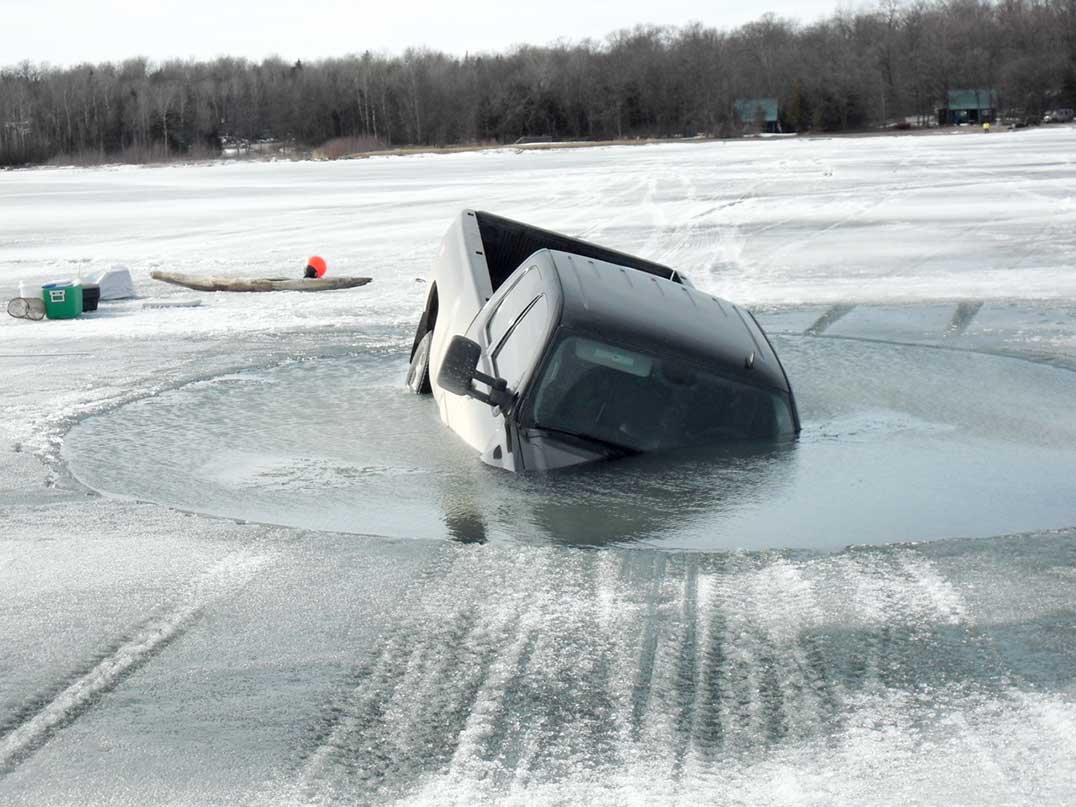LAKE WOLSEY—The truck that sank in Lake Wolsey recently will likely remain floating in place for a while yet, as unsafe ice conditions have complicated recovery efforts.
Larry Bartlett, of Larry Barlett Towing, a North Bay based company that specializes in recovery of vehicles from lake bottoms, was onsite with his crew shortly after the truck made its unscheduled trip through the ice, and work was well underway to rescue the vehicle, but conditions quickly took a dramatic turn.
“We went up last week after we got the call from the insurance company and starting working on it first thing,” said Mr. Barlett. “The ice was beautiful.”
The recovery expert explained that the crew tests the ice with a pick going out to the scene. “A lot like the kind you would use to chip ice in your driveway,” he said. “When we started out the ice pick hardly went in an inch.”
Then came a few hours of torrential downpour coupled with unseasonably high temperatures.
“By that afternoon, six hours later, the pick went straight through 16 inches of ice,” said Mr. Barlett. “It had just turned into honeycomb.”
From a relatively safe and sound base the world had turned swiftly to dangerous unsound ice.
Mr. Barlett, whose company he estimates has recovered over 60 sunken vehicles in the past 15 years (the company has been towing for 30), said that he has never understood chancing taking a vehicle out onto the ice when the temperatures start to rise. “Back in the day, when we had to fish for food, maybe, but not now,” he said.
Mr. Barlett said that it is far easier to work from the ice, but that his company has to put safety first.
The decision to go out on the ice is costly, but Mr. Barlett was hesitant to estimate an average. “It’s a lot like asking ‘how much does it cost to build a house?’ There are a lot of variables with each job,” he said. “If we had been able to go out and do the job (on Lake Wolsey) in one day, it would have likely come in under $10,000.” Now all bets on that prediction are off, but there was some good news.”
“Because the bumper was still sticking out, we were able to attach a line and airbags to the vehicle,” explained Mr. Barlett. Under normal circumstances, the team would have cut a series of holes to the shoreline (the vehicle is located some distance from shore), passing the rope from hole to hole to the shore, where it would be attached to a winch mechanism.
“Then we would sink the truck to just under the ice and float it in,” said Mr. Barlett. Once near the shore, the team would have cut a channel that would allow them finish pulling the truck onto the shore.
“Now we will likely have to wait until the ice is out,” he said. “But then the weather has gotten colder, so we will have to reassess the situation and we may be able to move forward.”
For vehicle owners caught in the situation of having their vehicle go through the ice the good news is that they are likely covered under their insurance. “Most people are insured for at least the recovery,” he said. “If they have full insurance, they may even be covered for replacement.”
While that may be some consolation, it hardly covers the danger of the situation for the driver and their passengers and the environmental impact of leakage from the vehicle.
And then there is the environmental (and associated legal) implications. “In accordance with ministry regulations, every person who discharges a contaminant into the natural environment shall immediately notify the ministry if the discharge causes or is likely to cause an adverse effect,” explained Steven Moggy, environmental officer with the Ministry of the Environment and Climate Change Sudbury office citing the regulations. “Persons responsible for a discharge of a contaminant also have a duty to mitigate any effects of the spill.” That means if you spill it, you pay to have it cleaned up.
So far, there have been no reports of leakage or a spill from the Lake Wolsey incident.
So will charges be laid regarding the vehicle that went through the ice in Lake Wolsey (or the snowmachine that went through the ice in McGregor Bay)? “It’s too early to determine if any charges will be laid,” responded Mr. Moggy. “Right now we’re focused on ensuring that the vehicles will be removed. We have had no reports of any spill at this time. In the event that there is a spill, persons who cause or permit the discharge of a contaminant to the natural environment so that there is damage to the natural environment can be ordered to repair the damage. The Ministry will continue to monitor the incidents to ensure there is no spill or environmental impact as a result of these incidents and that the vehicles will be removed.”






